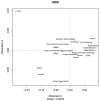Y Chromosome Story-Ancient Genetic Data as a Supplementary Tool for the Analysis of Modern Croatian Genetic Pool
- PMID: 38927684
- PMCID: PMC11202852
- DOI: 10.3390/genes15060748
Y Chromosome Story-Ancient Genetic Data as a Supplementary Tool for the Analysis of Modern Croatian Genetic Pool
Abstract
Due to its turbulent demographic history, marked by extensive settlement and gene flow from diverse regions of Eurasia, Southeastern Europe (SEE) has consistently served as a genetic crossroads between East and West and a junction for the migrations that reshaped Europe's population. SEE, including modern Croatian territory, was a crucial passage from the Near East and even more distant regions and human populations in this region, as almost any other European population represents a remarkable genetic mixture. Modern humans have continuously occupied this region since the Upper Paleolithic era, and different (pre)historical events have left a distinctive genetic signature on the historical narrative of this region. Our views of its history have been mostly renewed in the last few decades by extraordinary data obtained from Y-chromosome studies. In recent times, the international research community, bringing together geneticists and archaeologists, has steadily released a growing number of ancient genomes from this region, shedding more light on its complex past population dynamics and shaping the genetic pool in Croatia and this part of Europe.
Keywords: Croatia; SEE; Y chromosome; ancient genetic data; modern genetic data.
Conflict of interest statement
The authors declare no conflicts of interest.
Figures




References
-
- Karavanić I., Janković I. The Middle and Early Upper Paleolithic in Croatia. Opvscvla Archaeol. 2006;30:21–54.
-
- Vujević D. Adriatic Connections: Exploring Relationships from the Middle Palaeolithic to the Mesolithic. In: Davison D., Gaffney V., Miracle P.T., Sofaer J., editors. Croatia at the Crossroads: A Consideration of Archaeological and Historical Connectivity. Archaeopress; Oxford, UK: 2016. pp. 19–32.
Publication types
MeSH terms
Substances
LinkOut - more resources
Full Text Sources
Miscellaneous

